Characterization of Shock Wave Damages in Explosion Welded Mo/Cu Clads
Abstract
:1. Introduction
2. Experimental Details
3. Results and Discussions
3.1. LCV Clad
3.2. HCV Clads
3.3. Shock Wave Damage in HCV Clads
4. Conclusions
- (i)
- Cladding of a flyer Mo plate on a Cu plate succeeded under both the LCV and HCV conditions within the weldability window.
- (ii)
- The HCV clads exhibited larger bending elongation than the LCV clads. Crack was initiated at the surface of the Mo plate, and penetrated through the Mo plate and then propagated along the wavy interface without failure of the Cu plate. This suggests that the HCV condition can reduce the shock wave damage in the Mo plate.
- (iii)
- Micro defects such as cracks and voids were found at the topmost Mo plate of the clads. This indicates shock wave damage produced during the explosive welding. The visible and invisible defects in the Mo plate decreased bending elongation of the clad specimens.
- (iv)
- The shock wave damage was enhanced at the topmost Mo plate with higher hardness in the HCV4 clad, while the damage region was narrower since the remaining kinetic energy at the interface was smaller than that in the HCV2 clad. The bending elongation of HCV2 and HCV4 specimens increased with removing the region with the shock wave damage. The shock wave damage regions depended on the remaining kinetic energy at the collision interface estimated based on the plate velocity, the imparted kinetic energy, and kinetic-energy loss at the interface.
- (v)
- Heat generation due to the intermediate-layer formation at the HCV conditions leaded to loss of the imparted kinetic energy, and the related remaining kinetic energy at the collision interface depended on the Mo-plate thickness as well.
Author Contributions
Funding
Institutional Review Board Statement
Informed Consent Statement
Data Availability Statement
Acknowledgments
Conflicts of Interest
References
- Yang, Y.; Li, Z.; Cheng, X.; Zhu, X.; Pei, D.; Gao, W. Microstructure of Cu/Mo/Cu explosive clad interface. Rare Met. Mater. Eng. 2001, 5, 339–341. [Google Scholar]
- Yoshida, N. Review of recent works in development and evaluation of high-Z plasma facing materials. J. Nucl. Mater. 1999, 266-269, 197–206. [Google Scholar] [CrossRef]
- Linke, J. Plasma facing materials and components for future fusion devices-development, characterization and performance under fusion specific loading conditions. Phys. Scr. 2006, T123, 45–53. [Google Scholar] [CrossRef]
- Gale, W.F.; Totemeir, T.C. Smithells Metals Reference Book, 8th ed.; Elsevier Butterworth-Heinemann, The Boulevard: Oxford, UK, 2003. [Google Scholar]
- Zhang, Z.; Shen, Q.; Luo, G.; Li, M.; Zhang, L. Microstructure and bonding strength of diffusion welding of Mo/Cu joints with Ni interlayer. Mater. Des. 2012, 39, 81–86. [Google Scholar] [CrossRef]
- Yano, S.; Matsui, H.; Morozumi, S. Structural observations of the interface of explosion-bonded Mo/Cu system. J. Mater. Sci. 1998, 33, 4857–4865. [Google Scholar] [CrossRef]
- Ng, K.W.; Man, H.C.; Cheng, F.T.; Yue, T.M. Laser cladding of copper with molybdenum for wear resistance enhancement in electrical contacts. Appl. Surf. Sci. 2007, 253, 6236–6242. [Google Scholar] [CrossRef]
- Findik, F. Recent developments in explosive welding. Mater. Des. 2011, 32, 1081–1093. [Google Scholar] [CrossRef]
- Liu, K.; Chen, P.; Feng, J.; Ran, C.; Wang, Y.; Zhou, Q.; Zhu, L. Fabrication and characterization of the Mo/Cu bimetal with thick Mo layer and high interfacial strength. Int. J. Refract. Met. Hard Mater. 2021, 94, 105383. [Google Scholar] [CrossRef]
- Pushkin, M.S.; Greenberg, B.A.; Ivanov, M.A.; Inozemtsev, A.V.; Patselov, A.M.; Besshaposhnikov, Y.P. Microstructure of joints Cu–Ta, Cu–Ti, Cu–Cu, produced by means of explosive welding: Fractal description of interface relief. Compos. Interfaces 2021, 28, 63–76. [Google Scholar] [CrossRef]
- Greenberg, B.A.; Ivanov, M.A.; Inozemtsev, A.V.; Pushkin, M.S.; Patselov, A.M.; Besshaposhnikov, Y.R. Comparative characterisation of interfaces for two- and multi-layered Cu-Ta explosively welded composites. Compos. Interfaces 2020, 27, 705–715. [Google Scholar] [CrossRef]
- Tian, Q.; Liang, H.; Zhao, Y.; Ma, H.; Shen, Z.; Sun, Y.; Yang, M. Interfacial microstructure of FeCoNiCrAl0.1 high entropy alloy and pure copper prepared by explosive welding. Coatings 2020, 10, 1197. [Google Scholar] [CrossRef]
- Najafi, S.; Khanzadeh, M.R.; Bakhtiari, H.; Seyedraoufi, Z.S.; Shajari, Y. Electrochemical investigation of dissimilar joint of pure Cu to AISI 410 martensitic stainless steel fabricated by explosive welding. Surf. Eng. Appl. Electrochem. 2020, 56, 675–683. [Google Scholar] [CrossRef]
- Gloc, M.; Wachowski, M.; Płociński, T.; Kurzydlowski, K.J. Microstructural and microanalysis investigations of bond titanium grade1/low alloy steel st52-3N obtained by explosive welding. J. Alloy. Compd. 2016, 671, 446–451. [Google Scholar] [CrossRef]
- Wachowski, M.; Kosturek, R.; Śnieżek, L.; Mroz, S.; Gloc, M.; Krawczyńska, A.; Malek, M. Analysis of the microstructure of an AZ31/AA1050/AA2519 Laminate produced using the explosive-welding method. Mater. Technol. 2019, 53, 239–243. [Google Scholar]
- McClelland, H.T.; Otto, H.E. Explosives compaction of composites. In Proceedings of the 4th International Conference of the Center for High Energy Rate Forming, Denver, CO, USA, 9–13 July 1973. [Google Scholar]
- Vaidyanathan, P.V.; Ramanathan, A.R. Design for quality explosive welding. J. Mater. Process. Technol. 1992, 32, 439–448. [Google Scholar] [CrossRef]
- Manikandan, P.; Lee, J.; Mori, A.; Hokamoto, K. Explosive welding of molybdenum/copper using underwater shock wave. Mater. Sci. Forum 2012, 706–709, 735–740. [Google Scholar] [CrossRef]
- Parchuri, P.K.; Kotegawa, S.; Yamamoto, H.; Ito, K.; Mori, A.; Hokamoto, K. Benefits of intermediate-layer formation at the interface of Nb/Cu and Ta/Cu explosive clads. Mater. Des. 2018, 166, 107610. [Google Scholar] [CrossRef]
- Parchuri, P.K.; Kotegawa, S.; Ito, K.; Yamamoto, H.; Mori, A.; Tanaka, S.; Hokamoto, K. Cladding of a crack-free W plate on Cu plates using explosive welding at higher collision velocity with lower collision angle. Results Mater. 2020, 5, 100023. [Google Scholar] [CrossRef]
- Inao, D.; Yamashita, T.; Tanaka, S.; Hokamoto, K. Visualization of shock wave behaviour propagation in different pressure transmitting medium. In Proceedings of the PSFVIP-11, Kumamoto, Japan, 1–3 December 2017. [Google Scholar]
- Hokamoto, K.; Nakata, K.; Mori, A.; Tsuda, S.; Tsumura, T.; Inoue, A. Dissimilar material welding of rapidly solidified foil and stainless steel plate using underwater explosive welding technique. J. Alloys Compd. 2009, 472, 507–511. [Google Scholar] [CrossRef]
- Bahrani, A.S.; Black, T.J.; Crossland, B. The mechanism of wave formation in explosive welding. Proc. R. Soc. Lond. A 1967, 296, 123–136. [Google Scholar]
- Onzawa, T.; Ishii, Y. Fundamental studies on explosive welding. Trans. Jpn. Weld. Soc. 1975, 6, 18–24. [Google Scholar]
- Kiselev, S.P.; Mali, V.I. Numerical and experimental modelling of jet formation during a high-velocity oblique impact of metal plates. Combust. Explos. Shock Waves 2012, 48, 214–225. [Google Scholar] [CrossRef]
- Gupta, R.C.; Kainth, G.S. Swinging wake mechanism for interface wave generation in explosive welding of metals. J. Appl. Mech. 1990, 57, 514–521. [Google Scholar] [CrossRef]
- Mendes, R.; Ribeiro, J.B.; Loureiro, A. Effect of explosive characteristics on the explosive welding of stainless steel to carbon steel in cylindrical configuration. Mater. Des. 2015, 51, 356–364. [Google Scholar] [CrossRef]
- Crossland, B.; Williams, J.D. Explosive welding. Met. Rev. 1979, 15, 79–100. [Google Scholar] [CrossRef]
- Zhou, Q.; Feng, J.; Chen, P. Numerical and experimental studies on the explosive welding of tungsten foil to copper. Materials 2017, 10, 984. [Google Scholar] [CrossRef]
- Manikandan, P.; Lee, J.O.; Mizumachi, K.; Mori, A.; Raghukandan, K.; Hokamoto, K. Underwater explosive welding of thin tungsten foils and copper. J. Nucl. Mater. 2011, 418, 281–285. [Google Scholar] [CrossRef]
- Manikandan, P.; Hokamoto, K.; Fujita, M.; Raghukandan, K.; Tomoshige, R. Control of energetic conditions by employing interlayer of different thickness for explosive welding of titanium/304 stainless steel. J. Mater. Proc. Technol. 2008, 195, 232–240. [Google Scholar] [CrossRef]

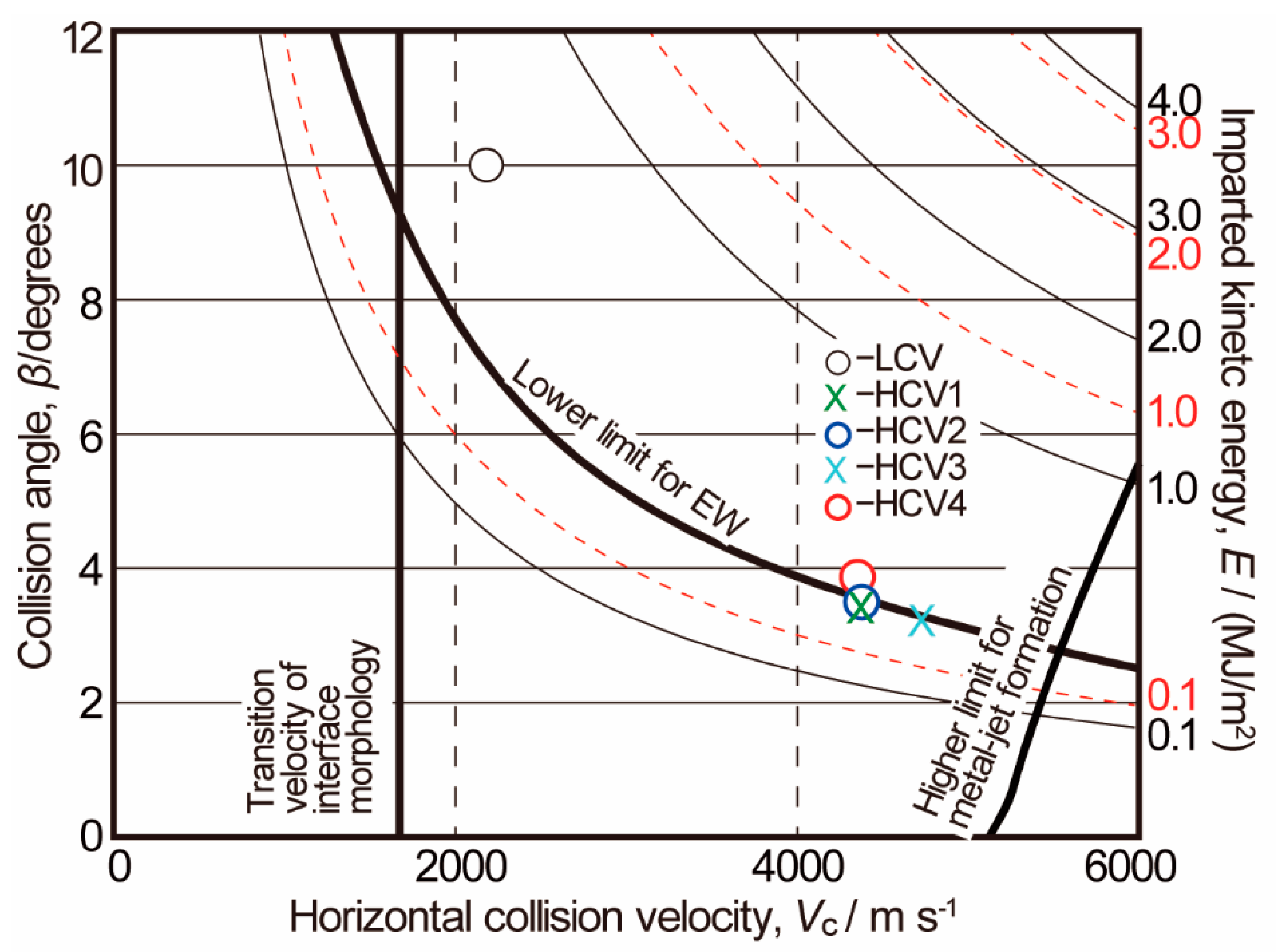

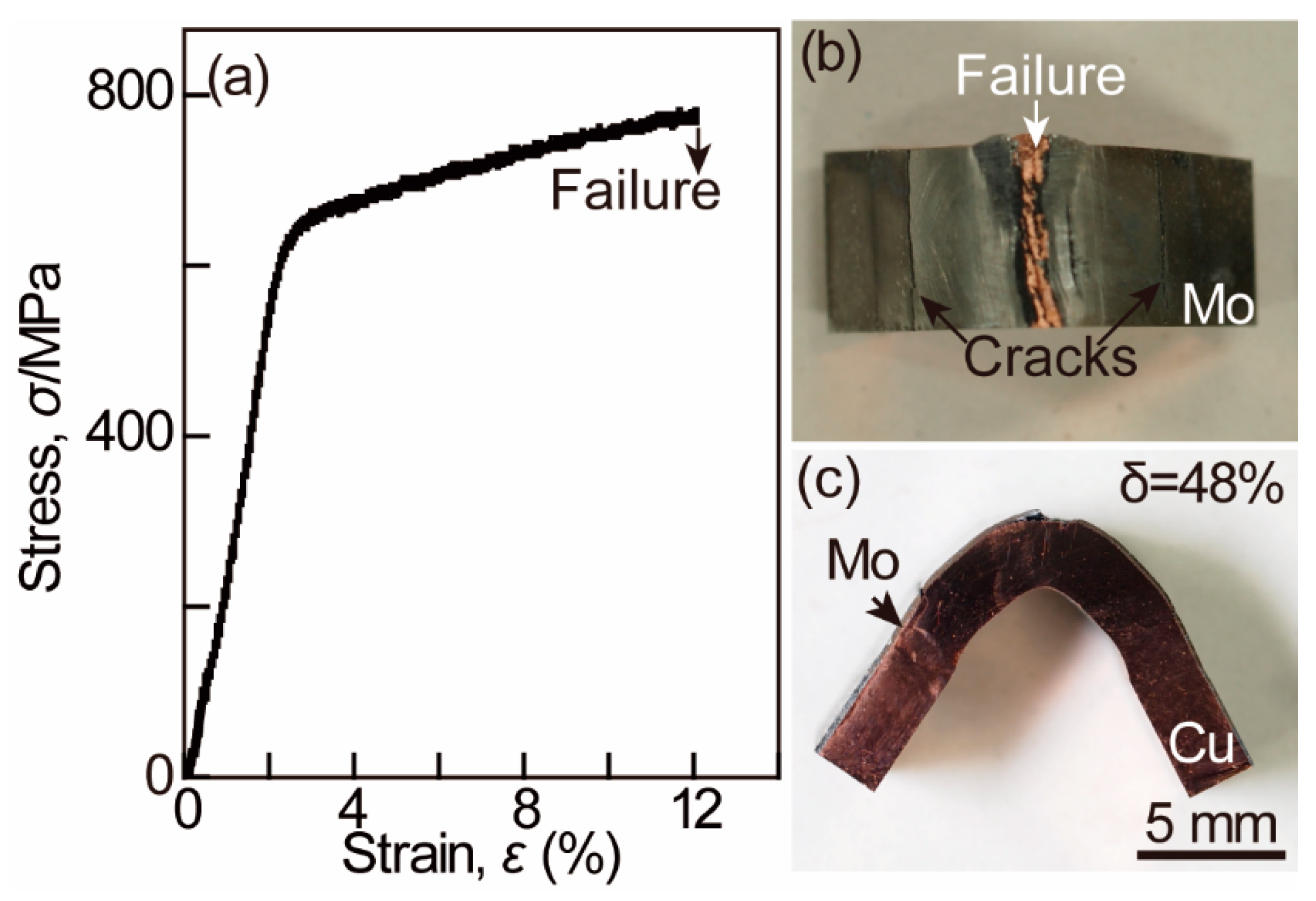
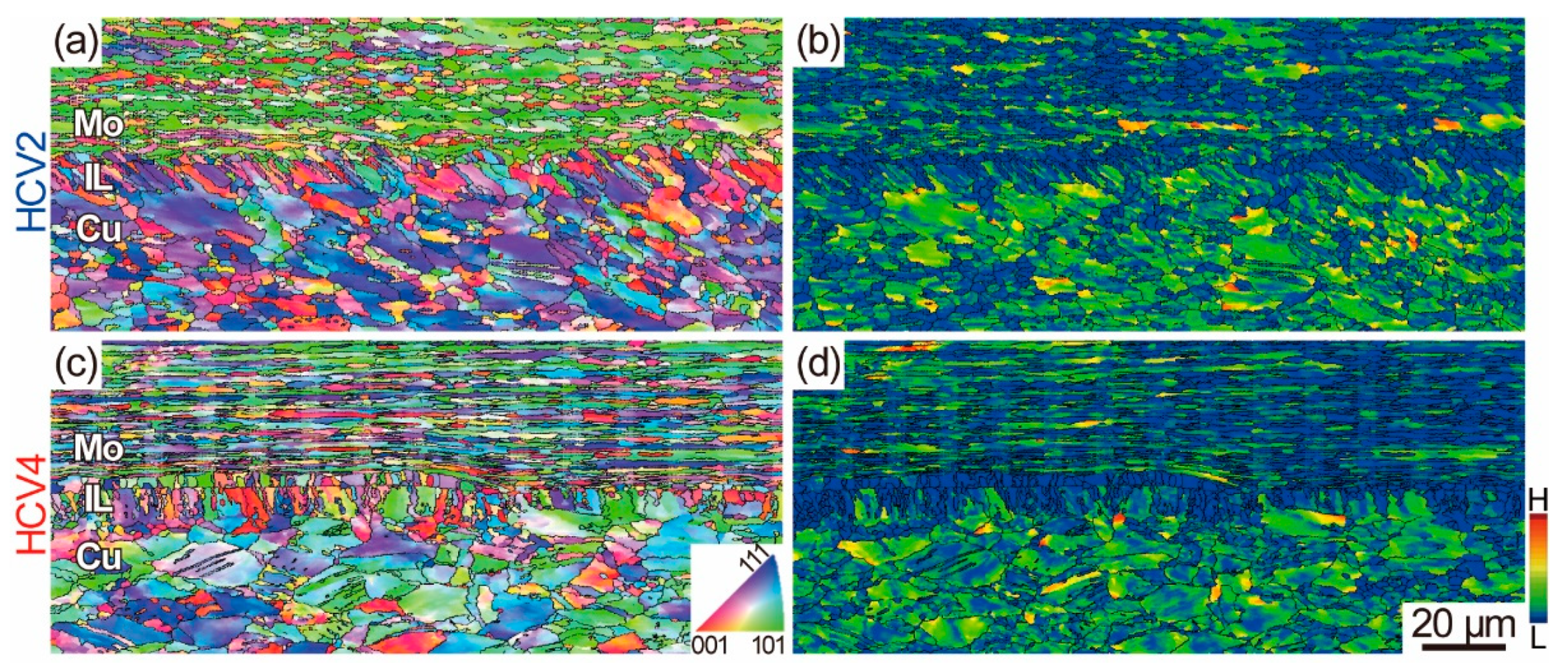

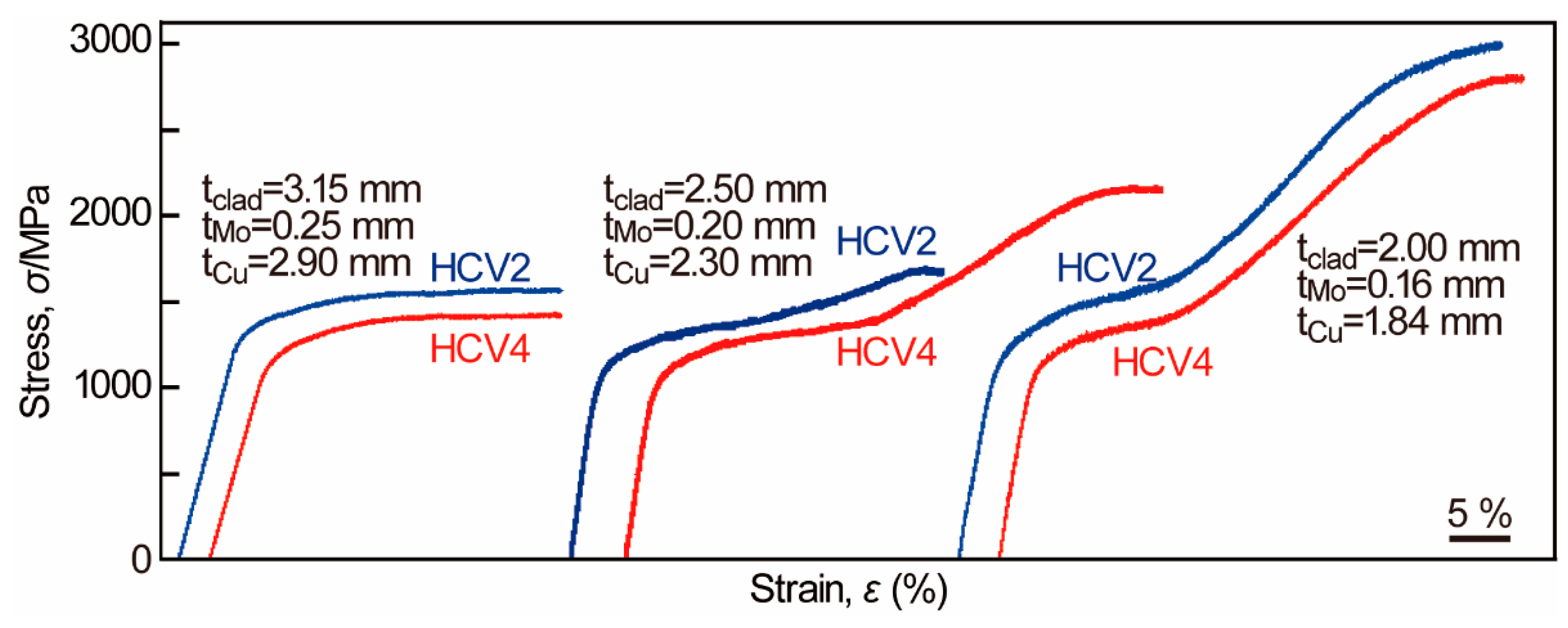
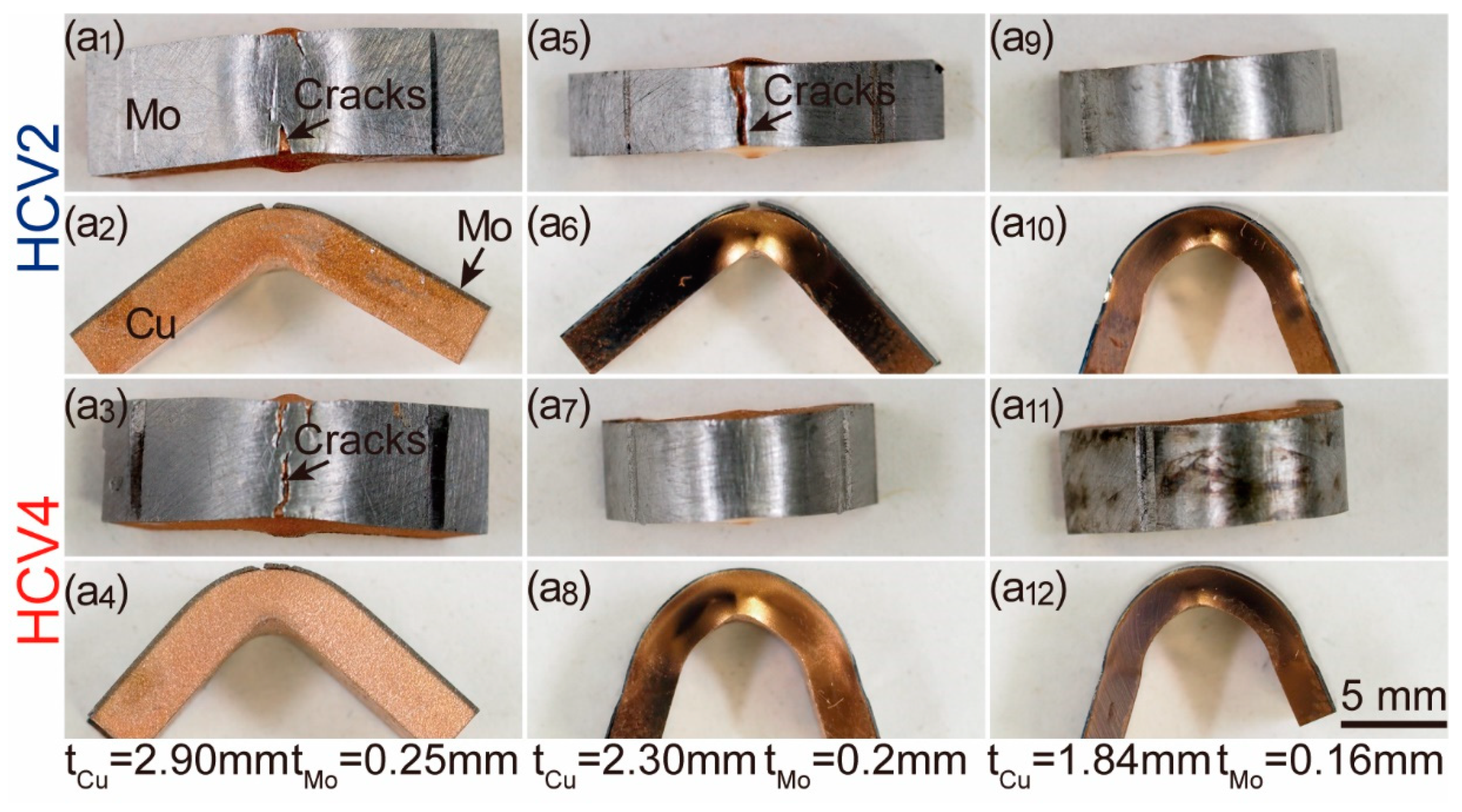

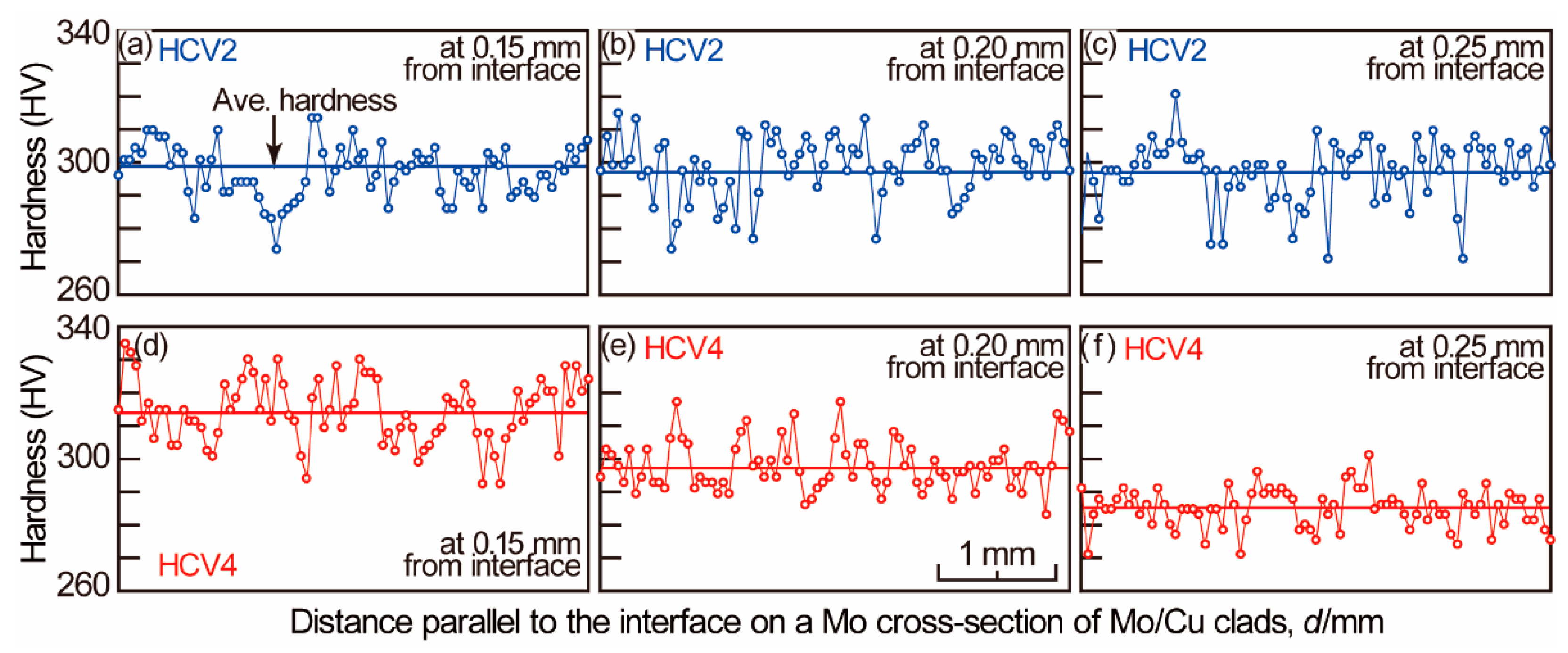
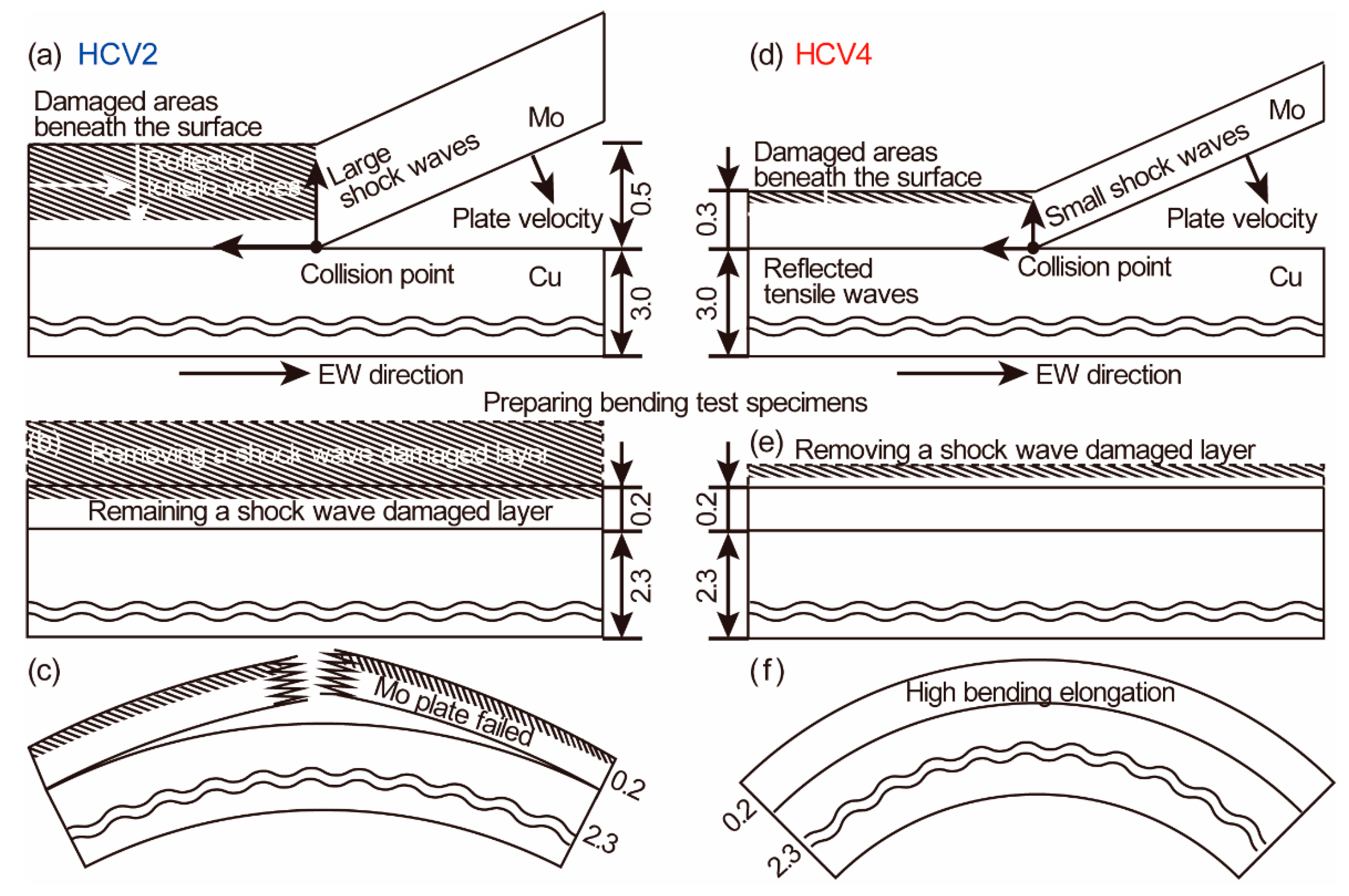
| Materials | Mo | Cu |
|---|---|---|
| Melting temperature (K) | 2896 | 1356 |
| Density (g/cm3) | 10.2 | 8.96 |
| Thermal conductivity (Wm−1K−1) at 300 K | 142 | 398 |
| Clads | Mo Plate Thickness dMo (mm) | Explosive Thickness d1E (mm) | Explosive Thickness d2E (mm) | Explosive Length lE (mm) | PMMA Plate Length lPMMA (mm) | Explosive Inclination Angle α (°) |
|---|---|---|---|---|---|---|
| HCV1 | 0.5 | 13.8 | 5 | 101.3 | 173.6 | 15 |
| HCV2 | 0.5 | 11.2 | 3 | 113.7 | 175.5 | 17.5 |
| HCV3 | 0.5 | 13.8 | 5 | 101.3 | 173.6 | 17.5 |
| HCV4 | 0.3 | 13.8 | 5 | 101.3 | 173.6 | 17.5 |
| Thicknesses, t/mm | Widths, w/mm | Fulcrum Distances, d/mm | |||
|---|---|---|---|---|---|
| Clads | Cu Plate | Mo Plate | HCV2 | HCV4 | |
| 2.5 | 2.3 | 0.2 | 3.98 | 4.09 | 13.5 |
| 2.0 | 1.84 | 0.16 | 4.81 | 4.98 | 12 |
| 3.15 | 2.9 | 0.25 | 5.95 | 5.86 | 15.45 |
| Codes | Plate Velocity (m/s) | Imparted KE (KJ/m2) | KE Loss at the Interface (KJ/m2) | Remaining KE at the Interface (KJ/m2) |
|---|---|---|---|---|
| LCV | 413.61 | 573.324 | 459.308 | 114.656 |
| HCV2 | 270.80 | 245.974 | 196.838 | 49.136 |
| HCV4 | 301.30 | 211.780 | 180.456 | 31.324 |
Publisher’s Note: MDPI stays neutral with regard to jurisdictional claims in published maps and institutional affiliations. |
© 2021 by the authors. Licensee MDPI, Basel, Switzerland. This article is an open access article distributed under the terms and conditions of the Creative Commons Attribution (CC BY) license (http://creativecommons.org/licenses/by/4.0/).
Share and Cite
Parchuri, P.K.; Kotegawa, S.; Ito, K.; Yamamoto, H.; Mori, A.; Tanaka, S.; Hokamoto, K. Characterization of Shock Wave Damages in Explosion Welded Mo/Cu Clads. Metals 2021, 11, 501. https://doi.org/10.3390/met11030501
Parchuri PK, Kotegawa S, Ito K, Yamamoto H, Mori A, Tanaka S, Hokamoto K. Characterization of Shock Wave Damages in Explosion Welded Mo/Cu Clads. Metals. 2021; 11(3):501. https://doi.org/10.3390/met11030501
Chicago/Turabian StyleParchuri, Pradeep Kumar, Shota Kotegawa, Kazuhiro Ito, Hajime Yamamoto, Akihisa Mori, Shigeru Tanaka, and Kazuyuki Hokamoto. 2021. "Characterization of Shock Wave Damages in Explosion Welded Mo/Cu Clads" Metals 11, no. 3: 501. https://doi.org/10.3390/met11030501
APA StyleParchuri, P. K., Kotegawa, S., Ito, K., Yamamoto, H., Mori, A., Tanaka, S., & Hokamoto, K. (2021). Characterization of Shock Wave Damages in Explosion Welded Mo/Cu Clads. Metals, 11(3), 501. https://doi.org/10.3390/met11030501







